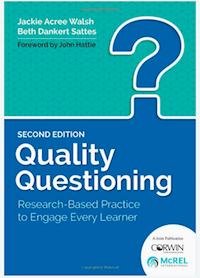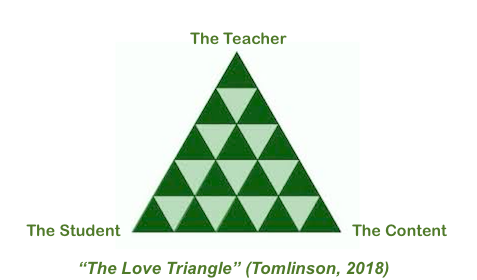March, 25, 2018, Boston, MA – Arriving almost an hour early to secure a “good seat,” I am anticipating the treat of listening to Carol Ann Tomlinson talk about “Differentiation or Personalization – What’s What?”
It’s a session I know will be standing-room only at ASCD’s Empower 18 conference in Boston. I choose a seat on the third row and wait a respectable 5 minutes or so before approaching Dr. Tomlinson to convey my gratitude for her important work on differentiation.
When I say to her, “I’m looking forward to better understanding the relationship between differentiation and personalization,” she quips, “So am I!” This grand lady and influential thought leader has a very wry sense of humor.
Standing before the 500 or so educators gathered to partake of her wisdom, Dr. Tomlinson acknowledges that she has been on a “thinking journey” over the past three years motivated by her interest in the topic before us.
Her intent this day is to share with us some highlights of her thinking, more specifically: the similarities and differences between the two approaches, examples of personalization, the role of the two models in how we do school, and what it would take to implement each model well.
The challenge to get differentiation right
From the outset, I sense a bit of frustration from this giant of teaching who for 30 years has focused her work on helping educators understand differentiation and to get it right.
Early on she states, “It is mightily hard to make the changes associated with differentiation, to do it in a meaningful way and not just gnaw around the edges.” Unspoken, but inferred by this listener, is the thought: While not all of us have fully embraced or mastered differentiated instruction, we’ve made a great deal of progress—and I hope we won’t be detoured by the newest shiny object. This, to me, did emerge as a recurrent theme in her presentation.
She indicates that she will focus on personalization, assuming that most of us in the room are familiar with her approach to differentiation, a model based on the premise that through strategic variations in content, process, and product, teachers can provide opportunities for mastery to learners at different places in the learning progression.
At the core of differentiation, she suggests is “artful teaching as a love triangle,” which she explains is about “connecting really important people to really important ideas.” Many of us know this as “the instructional core,” but isn’t the idea of a “love triangle” more in keeping with the passion that fuels teachers? Personally, I love this metaphor!
Before leaving differentiation, however, Dr. Tomlinson shares her favorite definition, one created by one of her students:
“Differentiation is a sequence of common sense decisions made by teachers with a student-first orientation that involves four critical elements: (1) ensuring an environment that actively supports students in the work of learning, i.e., an invitational environment; (2) absolute clarity about a powerful learning destination (i.e., KUDs—knowledge, understanding, dispositions); (3) persistently knowing where students are in relation to the destination; and (4) adjusting teaching to make sure each student arrives at the destination and, when possible, moves beyond it.”
What a simple, but compelling, definition! I understand why this professor is touting her student’s view—with some degree of pride, I might add.
Personalization and student-centered learning
At this point, our thought leader turns her attention to personalization, which she loosely equates with student-centered. I have never used these terms interchangeably, so my curiosity is heightened.
Referencing, Anytime, Anywhere: Student-Centered Learning for Schools and Teachers (R.E. Wolfe, A. Steinberg, & N. Hoffman, Eds., Harvard Education Press, 2013), Dr. Tomlinson shares four key components of student-centered:
(1) learning is personalized,
(2) learning is competency-based,
(3) learning happens anytime, anywhere; and
(4) students take ownership of their learning.
She embraces these four concepts, but asks: What is the curriculum? What do we mean by curriculum? How many degrees of freedom will we allow in defining the curriculum? She doesn’t answer these questions. I assume that they continue to drive her thinking journey.
As promised, our presenter offers an example of personalized learning, one that I infer to be one of her favorites — the Flexible Pathways Initiative, Act 77 enacted by the Vermont State Legislature in 2013. She shows what I believe to be a YouTube video, but, alas, I cannot locate the exact one. Back home, I did, however, locate a range of videos featuring Vermont students, teachers, and administrators at all levels talking about Act 77. (Just search YouTube, if interested.)
Dr. Tomlinson, who has worked with educators in Vermont, concludes this section by saying, “This is not really a new thing – it’s a new mindset.”
Continuing on this thinking journey, our conductor now takes us to a juncture that I believe continues to challenge her thinking and perhaps to produce for her some unease or disquiet. The questions raised by personalization, she suggests are: How do we think about changing the intent and nature of schooling? How are we to deal with radical changes in the nature and role of teachers? Again, she doesn’t offer her response, but suggests that the questions are worth continued thought.
The relationship with curriculum
As Dr. Tomlinson moves into the next segment of her presentation, I felt as though she is bringing us back to terra firma. She confesses that her “thing” is curriculum and that she believes it is important to think about differentiation, personalization, and curriculum in relation to one another. Using my best shorthand, I faithfully record what I believe will be some important take-aways:
- Differentiation is an instructional approach.
- Instruction is necessarily the accompaniment to curriculum, which is necessarily the melody.
- Instruction works in service of curriculum. It asks the question: How do we ensure that students learn what they need to learn?
- When curriculum is standardized, differentiation helps students learn.
- When curriculum is open, differentiation helps students learn whatever goals are established in this open context.
- Differentiation is no less necessary in either a closed or open curricular setting.
- “Real” personalization requires an open curriculum.
I continue to ponder these points, still attempting to determine the relationship between differentiation and personalization. My inferences: As an instructional strategy, differentiation is curriculum-independent. We can employ it whatever the content. Personalization, I’m beginning to think, embodies certain instructional practices—more wide-ranging and less well-defined than differentiation—but it assumes that “the what” of learning will be identified as a part of the personalization process. Note: I’m not sure I have this right!
Freedom within the curriculum
In any event, Dr. Tomlinson has now brought us back to her earlier questions about curriculum. I’m thinking that one of her big messages is this: First, decide what you want to teach, and, as she expressed it earlier, how many degrees of freedom you can offer? Then, think about how you will teach it.
Related to this, she suggests two huge barriers to the implementation of personalized learning (as she understands it).
► The most retractable, she says, is the value placed on standardized tests. Even now, she reports, most teachers struggle to balance differentiation with these high-stakes tests which dictate our curriculum.
► The second barrier, she believes, is preparing teachers to work in Vermont-type flexible classrooms.
Dr. Tomlinson is quick to add that she’d be very happy if we could overcome these barriers, “But, it’s BIG!”
The real questions
At this point, I’m realizing that she’s bringing the session to a close. How can it be that it’s already been 90 minutes? We need more minutes! What I’d really like is to have more time in a seminar-type setting to continue this thinking journey with this preeminent thought leader.
She’s moving to an inspirational close, I think, as I hear her say: “The question is not differentiation vs. personalization. The questions are: Who do we aspire to be as a people? How do we create the kind of schools that will shepherd teachers and their students to that place to which we aspire?” But then she quips something about the journey being “muddling to la-la land, uncomfortable and experimental.”
I then realize that her real purpose in this session was to light a fire within each of us to continue this perplexing “thinking journey” as we leave this time and space—maybe to engage in personalized learning in quest of our own answers?
Read another report from the ASCD Empower conference:
Leadership Lessons from Empower18 (Fred Ende)
 Dr. Jackie Walsh is the co-author with Beth D. Sattes of the bestselling Quality Questioning: Research-Based Practice to Engage Every Learner, 2nd Edition (Corwin, 2017) and Questioning for Classroom Discussion: Purposeful Speaking, Engaged Listening, Deep Thinking (ASCD, 2015). She is also lead consultant to the Alabama Best Practices Center where she designs and facilitates professional learning for ABPC’s statewide educator collaboratives and for the Alabama Instructional Partners Network. She lives in Montgomery, AL. Contact Jackie at [email protected] and follow her on Twitter @Question2Think.
Dr. Jackie Walsh is the co-author with Beth D. Sattes of the bestselling Quality Questioning: Research-Based Practice to Engage Every Learner, 2nd Edition (Corwin, 2017) and Questioning for Classroom Discussion: Purposeful Speaking, Engaged Listening, Deep Thinking (ASCD, 2015). She is also lead consultant to the Alabama Best Practices Center where she designs and facilitates professional learning for ABPC’s statewide educator collaboratives and for the Alabama Instructional Partners Network. She lives in Montgomery, AL. Contact Jackie at [email protected] and follow her on Twitter @Question2Think.





0 Comments on "ASCD’s Empower 18: On a Thinking Journey with Carol Ann Tomlinson"